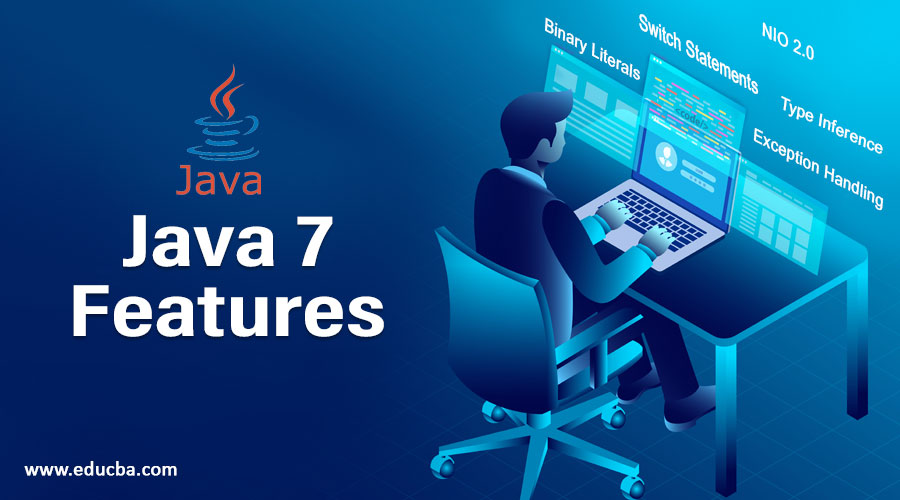Updated March 23, 2023
Introduction to Java 7 Features
As we all know that Java is a programming language that uses the concept of OOPs and it produces various programs for multiple platforms. When you write a java program, the bytecode will run on multiple operating systems including all Mac OS, Linux, and any windows version. The features of Java 7 are very much essential and easy to understand in all the ways. This latest version of java having its great enhancements to get a better appropriate program with improved quality. And moreover, it gives you more security and stability so that you can run on your machine without any failure. When you will go to install this java 7 it will ensure you that your program is safe to run with the highest security rate and with great efficiency because of its tremendous features.
Features of Java 7
Features of Java 7 are given below:
1. Binary Literals
This is the very first feature of java 7 which is very easy to understand. As we all know binary in simple terms well known for ‘0’ and ‘1’. But in java 7 it has its different binary format, in short, it expresses the literal part in binary format with prefix ‘0b’ or ‘0B’. Here you can use octal values. And we have to be specific whether we have to use byte, short, int and long.
2. Strings in Switch Statement
Switch statement is the basic in all the programming language and their syntax is different in all languages, it is specific for two values only i.e.int and enum types. Well as java 7 has some additional features so in that switch statement also it has come with the improved version in short, now it can be supported for string class also.
3. Automatic Resource Management
ARM is the one which is used to improve the quality of the program before ARM we have to use the finally blocks to clean up our resources but it is not fixed that we have to use the finally blocks only but the cleanup of resource is must because it is used to prevent our machines from being corrupt. Java 7 has awesome features and one of the feature i.e. ARM is the one is used for this purpose. All this cleanup process can be done automatically we don’t need explicit resource cleanup. All we have to do is simply initializing resource in try-with-resources block i.e. (try (…) {…}).
4. Multiple Exception Handling
Java 7 is the one that is come up with a very great enhancement if we look into the exceptional handling part. It is mainly denoted as suppressed exceptions and catch multiple exceptions in the catch block. If we consider suppressed exceptions from the name it’s clear that the exceptions can be ignored somehow and that will not generate any issues. Catch multiple exceptions can help you with multiple exceptional handling as before this java 7 we were restricted to only one catch block now we can take advantage of this to fulfill our needs.
5. Improved Type Inference
Previously while we were using generics we had to supply the parameters to the variables’ types and also actual types too. Well with the enhancement in the features of java 7 it has been improved a lot. Here is the compiler is smart enough to identify all the types.
6. NIO 2.0
It has introduced the various features and one of them is NIO 2.0 which is mostly referred to as a file. It has changed the file format of the java now it is mainly introduced as java.nio.file package which has its related packages and attributes also i.e. java.nio.file.attribute. It is all the time required for the support of the I/O file system. It has some basic and important class included i.e. path class which is used to represent the path value in the operating system in its own way and it supported all the API.
Conclusion
From all this, we can conclude that java 7 has its own features which is very beneficial for our basic programming. All the java 7 features have their own working that will help us to program the code in an error-free manner and in a limited time period.
Recommended Articles
This is a guide to Java 7 Features. Here we discuss the basic overview with top 6 features of java 7 which include, binary literals, strings in switch statements, automatic resource management, etc. You may also look at the following articles to learn more –


